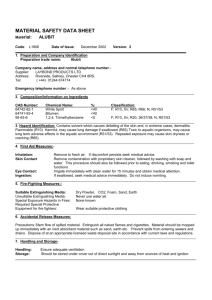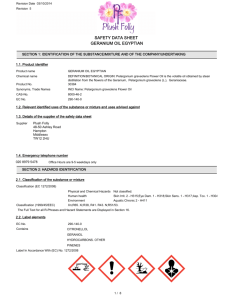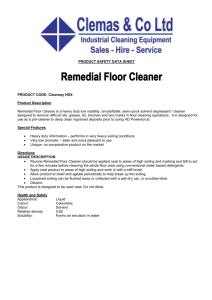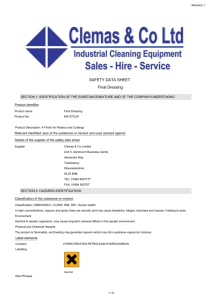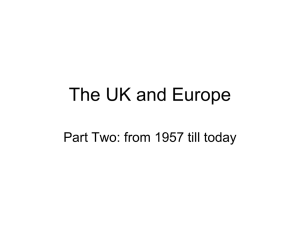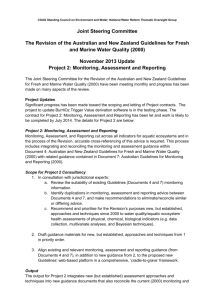2.1. Classification of the substance or mixture
advertisement
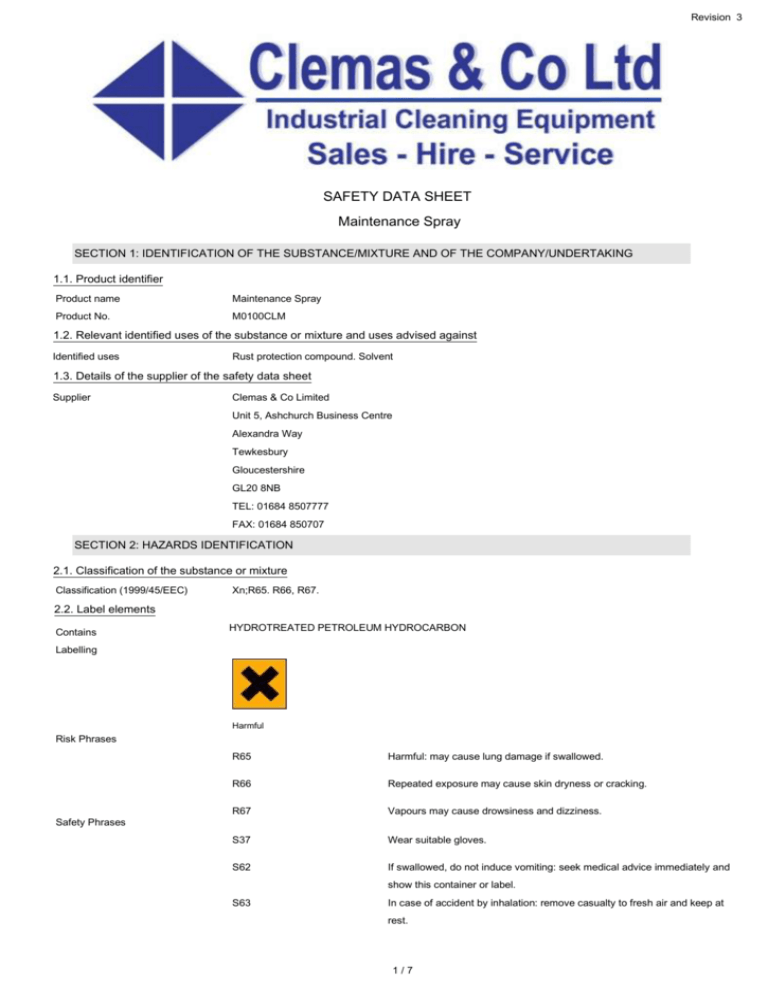
Revision 3 SAFETY DATA SHEET Maintenance Spray SECTION 1: IDENTIFICATION OF THE SUBSTANCE/MIXTURE AND OF THE COMPANY/UNDERTAKING 1.1. Product identifier Product name Maintenance Spray Product No. M0100CLM 1.2. Relevant identified uses of the substance or mixture and uses advised against Identified uses Rust protection compound. Solvent 1.3. Details of the supplier of the safety data sheet Supplier Clemas & Co Limited Unit 5, Ashchurch Business Centre Alexandra Way Tewkesbury Gloucestershire GL20 8NB TEL: 01684 8507777 FAX: 01684 850707 SECTION 2: HAZARDS IDENTIFICATION 2.1. Classification of the substance or mixture Classification (1999/45/EEC) Xn;R65. R66, R67. 2.2. Label elements Contains HYDROTREATED PETROLEUM HYDROCARBON Labelling Harmful Risk Phrases Safety Phrases R65 Harmful: may cause lung damage if swallowed. R66 Repeated exposure may cause skin dryness or cracking. R67 Vapours may cause drowsiness and dizziness. S37 Wear suitable gloves. S62 If swallowed, do not induce vomiting: seek medical advice immediately and show this container or label. S63 In case of accident by inhalation: remove casualty to fresh air and keep at rest. 1/7 Revision 3 Maintenance Spray S26 In case of contact with eyes, rinse immediately with plenty of water and seek medical advice. 2.3. Other hazards SECTION 3: COMPOSITION/INFORMATION ON INGREDIENTS 3.2. Mixtures HYDROTREATED PETROLEUM HYDROCARBON CAS-No.: 60-100% EC No.: 919-857-5 Classification (EC 1272/2008) Classification (67/548/EEC) Flam. Liq. 3 - H226 Xn;R65. R66,R10,R67. EUH066 STOT SE 3 - H336 Asp. Tox. 1 - H304 GENERIC WHITE SPIRIT - R10 R65 CAS-No.: 64742-47-8 1-5% EC No.: Classification (EC 1272/2008) Classification (67/548/EEC) Flam. Liq. 3 - H226 Xn;R65. R10,R66. EUH066 Asp. Tox. 1 - H304 DIPROPYLENE GLYCOL MONO METHYL ETHER CAS-No.: 34590-94-8 1-5% EC No.: 252-104-2 Classification (EC 1272/2008) Classification (67/548/EEC) Not classified. Not classified. PENTYL 22-HYDROXYBENZOATE CAS-No.: 2050-08-0 < 1% EC No.: 218-080-2 Classification (EC 1272/2008) Classification (67/548/EEC) Aquatic Chronic 2 - H411 N;R51/53. d-LIMONENE CAS-No.: 5989-27-5 < 1% EC No.: 227-813-5 2/7 Revision 3 Maintenance Spray Classification (EC 1272/2008) Classification (67/548/EEC) Flam. Liq. 3 - H226 R10 Skin Irrit. 2 - H315 R43 Skin Sens. 1 - H317 Xi;R38 Aquatic Acute 1 - H400 N;R50/53 Aquatic Chronic 1 - H410 The Full Text for all R-Phrases and Hazard Statements are Displayed in Section 16. SECTION 4: FIRST AID MEASURES 4.1. Description of first aid measures Inhalation Move the exposed person to fresh air at once. Provide rest, warmth and fresh air. Get medical attention if any discomfort continues. Ingestion Rinse mouth thoroughly. Get medical attention if any discomfort continues. DO NOT INDUCE VOMITING! NEVER MAKE AN UNCONSCIOUS PERSON VOMIT OR DRINK FLUIDS! Skin contact Remove contaminated clothing. Wash the skin immediately with soap and water. Get medical attention if any discomfort continues. Eye contact Make sure to remove any contact lenses from the eyes before rinsing. Promptly wash eyes with plenty of water while lifting the eye lids. Continue to rinse for at least 15 minutes. Get medical attention promptly if symptoms occur after washing. 4.2. Most important symptoms and effects, both acute and delayed General information The severity of the symptoms described will vary dependant of the concentration and the length of exposure. Inhalation. Irritation of nose, throat and airway. Ingestion May cause discomfort if swallowed. Skin contact Prolonged contact may cause redness, irritation and dry skin. Eye contact Irritating and may cause redness and pain. 4.3. Indication of any immediate medical attention and special treatment needed SECTION 5: FIREFIGHTING MEASURES 5.1. Extinguishing media Extinguishing media This product is not flammable. Use fire-extinguishing media appropriate for surrounding materials. 5.2. Special hazards arising from the substance or mixture Hazardous combustion products None under normal conditions. Unusual Fire & Explosion Hazards No unusual fire or explosion hazards noted. Specific hazards Not relevant 5.3. Advice for firefighters Special Fire Fighting Procedures No specific fire fighting procedure given. 3/7 Revision 3 Maintenance Spray SECTION 6: ACCIDENTAL RELEASE MEASURES 6.1. Personal precautions, protective equipment and emergency procedures Wear protective clothing as described in Section 8 of this safety data sheet. 6.2. Environmental precautions Do not discharge into drains, water courses or onto the ground. 6.3. Methods and material for containment and cleaning up Stop leak if possible without risk. Absorb in vermiculite, dry sand or earth and place into containers. Flush with plenty of water to clean spillage area. Collect in containers and seal securely. Do not contaminate water sources or sewer. 6.4. Reference to other sections Wear protective clothing as described in Section 8 of this safety data sheet. Collect and dispose of spillage as indicated in section 13. SECTION 7: HANDLING AND STORAGE 7.1. Precautions for safe handling Avoid spilling, skin and eye contact. Do not handle broken packages without protective equipment. 7.2. Conditions for safe storage, including any incompatibilities Store in tightly closed original container in a dry, cool and well-ventilated place. Keep in original container. Storage Class Chemical storage. 7.3. Specific end use(s) The identified uses for this product are detailed in Section 1.2. SECTION 8: EXPOSURE CONTROLS/PERSONAL PROTECTION 8.1. Control parameters Name STD TWA - 8 Hrs DIPROPYLENE GLYCOL MONO METHYL ETHER WEL 50 ppm d-LIMONENE OEL 30 ppm STEL - 15 Min Notes 150 ppm OEL = Occupational Exposure Limit. WEL = Workplace Exposure Limit. Ingredient Comments WEL = Workplace Exposure Limits GENERIC WHITE SPIRIT - R10 R65 (CAS: 64742-47-8) Ingredient Comments WEL = Workplace Exposure Limits 8.2. Exposure controls Protective equipment Engineering measures Provide adequate ventilation. Observe Occupational Exposure Limits and minimise the risk of inhalation of vapours. Respiratory equipment No specific recommendation made, but respiratory protection may still be required under exceptional circumstances when excessive air contamination exists. Hand protection 4/7 Revision 3 Maintenance Spray Use protective gloves. Eye protection Wear approved safety goggles. Other Protection Wear appropriate clothing to prevent any possibility of skin contact. Hygiene measures DO NOT SMOKE IN WORK AREA! Wash hands at the end of each work shift and before eating, smoking and using the toilet. Wash promptly if skin becomes wet or contaminated. Promptly remove any clothing that becomes contaminated. Use appropriate skin cream to prevent drying of skin. When using do not eat, drink or smoke. SECTION 9: PHYSICAL AND CHEMICAL PROPERTIES 9.1. Information on basic physical and chemical properties Appearance Light viscous liquid. Colour Amber. Odour Solvent. Relative density 0.8 9.2. Other information SECTION 10: STABILITY AND REACTIVITY 10.1. Reactivity No specific reactivity hazards associated with this product. 10.2. Chemical stability Stable under normal temperature conditions. 10.3. Possibility of hazardous reactions No information required. 10.4. Conditions to avoid Avoid excessive heat for prolonged periods of time. 10.5. Incompatible materials 10.6. Hazardous decomposition products Fire creates: Carbon monoxide (CO). Carbon dioxide (CO2). SECTION 11: TOXICOLOGICAL INFORMATION 11.1. Information on toxicological effects Toxicological information No information available. Eye contact Irritating to eyes. SECTION 12: ECOLOGICAL INFORMATION Ecotoxicity Not regarded as dangerous for the environment. 12.1. Toxicity Acute Fish Toxicity Not considered toxic to fish. 5/7 Revision 3 Maintenance Spray 12.2. Persistence and degradability Degradability No data available. 12.3. Bioaccumulative potential Bioaccumulative potential No data available on bioaccumulation. 12.4. Mobility in soil 12.5. Results of PBT and vPvB assessment This product does not contain any PBT or vPvB substances. 12.6. Other adverse effects SECTION 13: DISPOSAL CONSIDERATIONS General information Waste to be treated as controlled waste. Disposal to licensed waste disposal site in accordance with local Waste Disposal Authority. 13.1. Waste treatment methods Dispose of waste and residues in accordance with local authority requirements. SECTION 14: TRANSPORT INFORMATION General Not regulated. Road Transport Notes Not regulated. Rail Transport Notes Not regulated. Sea Transport Notes Not regulated. Air Transport Notes Not regulated. 14.1. UN number Not applicable. 14.2. UN proper shipping name Not applicable. 14.3. Transport hazard class(es) Not applicable. 14.4. Packing group Not applicable. 14.5. Environmental hazards Environmentally Hazardous Substance/Marine Pollutant No. 14.6. Special precautions for user 14.7. Transport in bulk according to Annex II of MARPOL73/78 and the IBC Code SECTION 15: REGULATORY INFORMATION 15.1. Safety, health and environmental regulations/legislation specific for the substance or mixture Statutory Instruments The Chemicals (Hazard Information and Packaging for Supply) Regulations 2009 (S.I 2009 No. 716). 6/7 Revision 3 Maintenance Spray Approved Code Of Practice Safety Data Sheets for Substances and Preparations. Classification and Labelling of Substances and Preparations Dangerous for Supply. Guidance Notes Workplace Exposure Limits EH40. CHIP for everyone HSG(108). EU Legislation Regulation (EC) No 1272/2008 of the European Parliament and of the Council of 16 December 2008 on classification, labelling and packaging of substances and mixtures, amending and repealing Directives 67/548/EEC and 1999/45/EC, and amending Regulation (EC) No 1907/2006 with amendments. National Regulations Regulation (EC) No 1907/2006 of the European Parliament and of the Council of 18 December 2006 concerning the Registration, Evaluation, Authorisation and Restriction of Chemicals (REACH), establishing a European Chemicals Agency, amending Directive 1999/45/EC and repealing Council Regulation (EEC) No 793/93 and Commission Regulation (EC) No 1488/94 as well as Council Directive 76/769/EEC and Commission Directives 91/155/EEC, 93/67/EEC, 93/105/EC and 2000/21/EC, including amendments. 15.2. Chemical Safety Assessment No chemical safety assessment has been carried out. SECTION 16: OTHER INFORMATION Revision Date 22/10/2012 Revision 3 Supersedes date 25/04/2012 Risk Phrases In Full R10 Flammable. R65 Harmful: may cause lung damage if swallowed. R38 Irritating to skin. R43 May cause sensitisation by skin contact. NC Not classified. R66 Repeated exposure may cause skin dryness or cracking. R51/53 Toxic to aquatic organisms, may cause long-term adverse effects in the aquatic environment. R67 Vapours may cause drowsiness and dizziness. R50/53 Very toxic to aquatic organisms, may cause long-term adverse effects in the aquatic environment. Hazard Statements In Full H315 Causes skin irritation. H226 Flammable liquid and vapour. H304 May be fatal if swallowed and enters airways. H317 May cause an allergic skin reaction. H336 May cause drowsiness or dizziness. EUH066 Repeated exposure may cause skin dryness or cracking. H411 Toxic to aquatic life with long lasting effects. H410 Very toxic to aquatic life with long lasting effects. H400 Very toxic to aquatic life. 7/7
